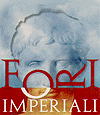History of
Rome
Rome and its numerous
centuries of history officially begin in 753 B.C. on the slopes of the Palatino hills,
when the Etruscans and Greek colonies occupied areas nearby. Tradition gave Romulus the
paternity of the village, tracing in the boundary with a plow.
From 509 B.C. until 27 B.C., the republican
supreme authority governed and was elected each year by the citizens, establishing the
base of civil law.
Rome, once a village, became the capital of an
empire in a few centuries and, with the Punic Wars, the undisputed ruler of the
Mediterranean Sea.
> Map of the Empire
The territorial and population expansion called
for a redefinition of the "republic", or the state. After the assassination of
Caesar (44 B.C.) affluent men disputed over the next successor of the new regime-the
princedom: Marco Antonio, Cleopatra's ally, or Caesar's adopted son Octavian, both of who
shared the rule after Caesar's death. The "princeps" (from primum caput" or
"first citizen") founded an empire in a unified and peaceful order that lasted
until the III century A.D. ("pax romana"). It was during these centuries that
the Roman empire reached its splendor.
With the III century A.D. Rome gradually lost its
central role as a kingdom of vastness and universality, until Diocletian separated the
empire into two parts, profoundly restructuring economy, finance, politics, and
bureaucracy. This guaranteed Rome a new century of prosperity while Christianity became
officially authorized in 313 A.D. by Constantine the Great with the issued edict in Milan,
contributing to the support of the regime.
In that period, Rome had about 4 million citizens
(free men, slaves excluded) and an empire of over 50 million.
In the IV century the nucleus of the empire began
to move toward the orient, after successive invasions by Barbarians, Visigoths, and
Vandals, that also came to plunder the city of Rome.
In the VI century, the Roman empire began to
disappear, leaving its mark in history as having created and unified the so-called
"civil world".
Enter into the knowledge of antique Rome through
these brief chapters:
> Rome Caput Mundi:
chronological table of historical events and map of the Empire
> Panem and Circenses:
entertainment, fundamental element for politics
> Rome and the
development of the Christian Catholic religion
> Index of the
Emperors
In the other chapters you can find: news
bulletins on archeological excavation advancements made in the in the Imperial Forum zone;
WebView in direct contact with the Forums; the reconstruction of antique buildings;
sayings and characteristics of the Antique Romans. Select the chapter from the four titles
in the black column on the right.
|



